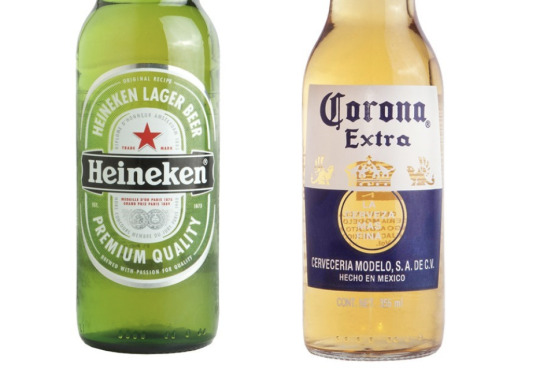Don't wanna be here? Send us removal request.
Text
"In the Relationship Era, the big winners will be in Sustainable”
The Relationship Era refers to a new trend within Marketing where the relationships between consumers, suppliers, employees, shareholders, and the Earth determine the success of both a brand and the company underneath the brand. Thus the companies that are most set up for success are the ones that do not have to rely on expensive advertising, but have a strong positive brand built up over time. In other words, they have established the necessary relationships to be able to rely on
The exemplary companies in the “Sustainable” category are said to be Amazon, Apple, and Southwest Airlines, but for me personally the more memorable examples that demonstrate that reaching the Sustainable quadrant is doable for any company but will be a slow and steady process are Chipotle and Starbucks. In both cases, the companies at one point were low in consumer trust but turned around the company’s brand by taking the right measures to invest in relationship-building.
In the case of Chipotle, the numerous reports of E.coli and norovirus outbreaks in a short span of time really caused the brand reputation to tank a few years back. While each case was addressed through investigations and public remarks from the company, Chipotle’s management team realized the brand would not survive the reputational damage no matter what the messaging is if the number of outbreaks does not subside.
The key was to prioritize sustainability and food safety as top values of the company and run campaigns to associate their efforts related to this with the Chipotle name in the minds of consumers. They went to the extent of shutting down all of their locations nationwide for a few hours until the entire company was aware of a plan in plan to improve their food safety. This took place back in 2015 and their stock price took years to fully recover, but as of today the brand appears to have redeemed itself based on the gradual rise in stock price and stable finances.
Outbreaks are much fewer but still occur, but the brand has successfully transitioned close to if not into the Sustainable quadrant so that their commitment fo sustainability and safety are widely known and acknowledged.

As for Starbucks, the story is similar in that the company for a while was under heavy scrutiny and criticism for the taking advantage of the coffee farmers that are part of their product supply chain. With coffee being a massive global commodity, Starbucks is only one of many suppliers but as a powerful brand it was especially under fire for not improving its farmer equity practices.
Thus the company like Chipotle promoted its dedication to corporate social responsibility, particularly with regards to farmer equity. To complement this campaign, Starbucks has invested in a series of other initiatives including humanitarian donations, sustainable practices, and nondiscriminatory workspace practices.

No brand is entirely safe from criticism or losing its hard-earned trust among consumers, but a brand that knows how to turn around a situation of being in hot waters to re-establishing a positive brand image can credit themselves for successfully entering the “Sustainable” category at least for a while. As with any relationship, the relationships can be easily broken but while they’re enjoying the benefits of being in Sustainable they can save themselves from the costs of heavy advertising that are more critical for companies in the other 3 categories.
2 notes
·
View notes
Text
Burberry: Sustainable rebranding?
Burberry’s signature check design was plateauing in its fresh appeal when the company successfully rebranded itself from stodgy to hip.

We often see though that brands “under attack” or simply in need of a make-over because of stagnating customer growth manage to refurbish its reputation if the company invests the necessary new management, marketing campaigns, and product lines. Examples of companies other than Burberry that this applies to include Apple, Chipotle and McDonald’s.
The real challenge, however, is the sustainability of the rebranding effort. The “high” from a revamping of a brand can only last so long, and it’s easy for a company to rely on this high for more than it is meant to last for. In the case of Burberry, it seems to be headed in the right direction under Bravo’s leadership in 2004 with the expansion of its product lines including expansion into men’s fashion and fragrances and plans to include a kid’s product line. Any kind of major pivot is worth seeing through before deeming successful or unsuccessful, since Burberry will have the challenge of maintaining continuous product offerings that stay with the latest fashion trends and appeal to the masses. Especially with trying to expand its target audience, keeping up with the latest trends will be increasingly important and necessary in order for it to stay ahead of its competitive amongst other luxury brands such as Polo, coach, Armani, Gucci, and the likes.

With how competitive the luxury brands sector is, whether Burberry’s rebranding under Bravo is sustainable or not will be determined by the first year or so following the rebranding initiatives. Therefore it’s a question to be determined at the time of the case.
0 notes
Text
Customer service “innovation”
Singapore Airlines (SIA) may be credited with pioneering “customer service innovation”, but superior customer service isn’t something that is exclusive to a single company. Unlike super products, customer service isn’t intellectual property that competitors would be unbeknownst to or unable to replicate. While it may be challenging initially given the head start that the pioneering company had, rival companies are perfectly capable of offering high caliber customer service and thus can dilute how much of a competitive advantage customer service actually is.

SIA benefited from over a decade of top customer satisfaction and strong revenues thanks to its reputation as a premium customer service experience for its flyers, but eventually other players caught up so that it wasn’t the sole airline competing for flyers who are willing to pay a premium for quality customer service. Especially today, SIA is one of several airlines rather than the airline with top-notch customer service.
This then raises the question of whether there is such a thing as customer service “innovation” if it’s less about reinventing the wheel and doing something unique and more about prioritizing customer service enough to buy you time before others do something similar.
Furthermore we now see the definition of customer service evolving to keep up with the digital age. Customer service does not necessarily mean the customer’s experience with in-person services is pleasant, as it has been traditionally, but it can also mean that an individual’s experience using a product is so positive that the company’s services are considered top customer service.

For example an Amazon customer generally involves zero human interaction, but the company is known for being a customer-obsessed company because of its quick turnaround on orders and the ease and convenience of using its platform.
It is uncertain therefore whether SIA truly has a sustainable competitive edge, especially at the time of the case where it must make tough business decisions based off of recent accidents. My advice would be to invest in a super customer experience in ways outside of just in-person service rather than continuing to rely on that alone to make it a leader in the airlines industry.
0 notes
Text
To go from the bottom up or the top down, that is the question
The decision for Concha y Toro to move away from the lower end market vs. strive for economies of scale among the lower end buyers in early 2006 shows that the latter is clearly less risky, has more of a track record of success for other brands, and seemingly has more benefits if successful. Thus the “top-down” strategy appears much more appropriate, but if I were in Rafael Guilisasti’s position I would pursue a hybrid approach where the “top-down” strategy later leads to a “bottom-up” strategy.
Concho y Toro needs high volume to successfully expand its production and thereby improve margins. Without first securing a large customer base and solidifying its presence in numerous markets around the world, Concho y Toro would be taking on a significant risk by transitioning to an elite, high-end brand and market segment. Especially given its previous challenges with convincing consumers of the quality of both Concho y Toro and general Chilean wines, firmly securing widespread demand is a necessary first step now that a positive brand image has been gradually established.

Once Concha y Toro reaches economies of scale, I would suggest investing in initiatives to promote the Concha y Toro brand as high end. Similar to Toyota’s strategy with Lexus, Concha y Toro may have to launch a sub-brand that is specifically associated with the higher end wine products. In order to stay ahead of any price wars down the road and to differentiate from other mass produced wines, it would be worthwhile for Concha y Toro to invest in refining its brand as more than just high-production, affordable wines. If the perception of its brand is truly around quality, charging a price premium over competitor brands in the lower end segment should theoretically be feasible. This comes secondary to volume, but is a step towards long-term sustainability as a brand especially if the wine industry were to become increasingly competitive and focused on low margin production. The key in making this effort successful though would be the branding campaigns that are able to “sell” consumers on the perceived quality of Concha y Toro, not necessarily the actual quality. In other words, the production would stay unchanged but how consumers think of Concha y Toro would have to adjust based on the messaging of its brand marketing.
2 notes
·
View notes
Text
“Fun, Sun, Beach” or Mexican soda pop
Heineken, as the brand standing in the way of Corona fully realizing its aspiration to become the leading imported beer in every country where they do business, has been Corona’s archnemesis since Corona entered the US market.

While Corona was terribly not far behind Heineken in the late 1990s, Corona would have to come up with a new product, new branding campaign, or something similarly new and original. Interestingly the 2 brands have very different marketing approaches: Heineken had historically emphasized quality (even explicitly stating “premium quality” on their bottles), whereas Corona maintained a consistency in messaging across all regions of a simple “Fun, Sun, Beach” drink.

Heineken may have successfully maintained dominance in the US market since prohibition was lifted, but they had several rebranding failures in the 1990s as they attempted to pivot into a less pretentious brand image and made organizational and staffing changes as a result. This period of trial of error, however, presents Corona with a prime opportunity to gain market share by investing more in its advertising to make the most of its recovered brand after years of unfounded and highly detrimental rumors.
While segmenting its messaging through a series of regional campaigns may help to connect with consumers with more customized campaigns, the segmentation may be a significant lift and would go against Corona’s reputation of maintaining a single, consistent message. Instead it could deepen the meaning of the Corona brand among consumers as a fun, casual drink that lets consumers relax as if they are on a vacation. Especially given the Heineken’s revelation that their brand reportedly gives the impression of slight pretentiousness and exclusivity as a “premium quality” brand, I would consider a new campaign that continues the “Fun, Sun, Beach” theme but with an added twist of being a universally friendly and unifying drink could help Corona gain market share by converting consumers who are not tied to any one brand.
A successful spin on the “Mexican soda pop” critique so that the Corona brand name is as approachable and convenient as a soda pop drink in the minds of consumers would have Heineken’s management team regretting their words.
0 notes
Text
First Mover Advantage & Positioning
In 2002, Intel was faced with the challenge of strategizing around its branding strategy to avoid jeopardizing its brand equity built over years of successful “Intel Inside” campaigns but also positioning the Intel brand appropriately with the movement towards mobile and digital devices over PCs. Inherent to the fast-faced technology space is relatively short trends and thus the need to constantly iterate and innovate in order to remain as a dominant player and stay ahead among competitors.
In the case of Intel’s success in the PC market, the “Intel Inside” campaign was successful because the products were truly of high quality, as promoted in the campaign, and Intel was an early player in developing processors compatible across operating systems and with new and advanced capabilities. Because Intel was able to beat its rival companies in releasing faster processors and promoting them, it managed to retain market share and stay competitive.

Based on my personal observations of the evolving technology industry over the last decade or so, companies are only able to stay dominant if they take risks in their attempts to innovate. If company growth is stagnant, the extreme competition ultimately pushes out companies that are too slow to release new products or only offer incremental improvements rather than trend-setting features unlike that of competitors.
In other words, the aforementioned challenge that confronted Intel in 2002 basically had to be addressed with some risk-taking in its branding campaigns if Intel were to keep up with the movement towards digital. Otherwise it’d be a matter of time before Intel was branded as an old-school company that is only able to deliver within the PC market and not in the mobile market.

As an Intel executive having to decide Intel’s next move, I may consider ways to experiment and conduct studies prior to launching a new product or a new branding campaign but the focus would be on how to be the first mover to the digital market. The risk with damaging years of brand equity I would believe to be minimized with the appropriate due diligence of pre-launch research and executing through a phased rollout with carefully picked audiences for each phase. Rather than stick to a conservative approach of staying a computer-associated company, the goal would be to rebrand into an overarching technology company capable of producing chips for any device.
0 notes